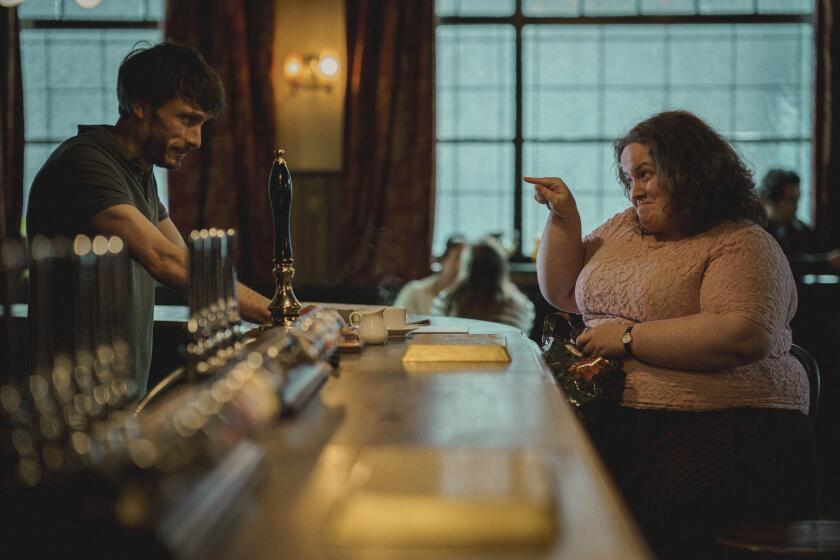Breathing life, depth into ‘Six Feet Under’
The TV show set inside a funeral home is about to bite the dust. After the last episode of HBO’s deliciously dark “Six Feet Under” airs Aug. 21, the fictional Fisher clan will be gone. And set decorator Sandy Lipscomb will have lost a family she knows almost as intimately as her real-life husband and four kids.
To hear her talk about the Fishers, an oddly dysfunctional family who own, run and live above a Los Angeles-area funeral home and who, quite literally, see dead people every day, you might assume they are real folks in whose home Lipscomb has been a boarder and a snoop.
For the record:
12:00 a.m. July 28, 2005 For The Record
Los Angeles Times Thursday July 28, 2005 Home Edition Home Part F Page 6 Features Desk 0 inches; 27 words Type of Material: Correction
TV show -- An article in last week’s Home section gave an incorrect first name for “Six Feet Under’s” set decorator. She is Rusty Lipscomb, not Sandy.
For The Record
Los Angeles Times Saturday July 30, 2005 Home Edition Main News Part A Page 2 National Desk 0 inches; 31 words Type of Material: Correction
“Six Feet Under” -- An article in the July 21 Home section about set decoration on the TV show “Six Feet Under” referred to set decorator Rusty Lipscomb as Sandy Lipscomb.
There’s repressed mother Ruth, conflicted sons Nate and David, angst-ridden and artsy daughter Claire. Lipscomb knows what’s in their bedside drawers, what childhood trophies and toys they’ve kept, whether they’re messy or neat, what colors, foods and furniture they like -- and probably a great many more intimate details that can’t even be suggested here.
She knows all this not from reading the scripts, which offer no such details, but from hours spent delving into each of the Fishers’ psyches, she says, imagining how they developed from the time they were kids, why they’ve selected (or rejected) certain signature looks, lovers, friends. And from those ruminations, she and colleagues on the set decided what kind of home and what possessions each might have.
“Scripts are black and white,” Lipscomb says. “A set decorator uses imagination to color it in.” Although her job, technically, is to supply items that reflect the Fishers’ lives, she says her main attachment “is not to the family’s physical things, but more to their emotions and thoughts.”
From the start, the anchor for the series has been the rambling old Fisher manse with its embalming room, slumber room (where grieving kinfolk view the dead) and a warren of private living spaces where the family hangs out. The house has symbolized to viewers the entire Fisher family panorama and gestalt. Just one shot of the aging, stately, verging-on-seedy house can evoke the show’s entire arc.
Rabid fans have debated on the Internet whether the house is in Pasadena or not. It’s not.
Alan Poul, an executive producer of the show since its inception, says the Pasadena rumor started early, when the show’s creator, Alan Ball, “arbitrarily [and temporarily] decided the Fishers lived in Pasadena in a certain kind of house. When we began looking for the right house, the actual location to shoot, we found it at 25th and Arlington, in the West Adams district.” An HBO news release about the show incorrectly mentioned Pasadena as the Fisher home location, the media picked it up, and the misinformation spread.
In fact, neither Ball nor anyone else involved in the pilot episode knew exactly where or what kind of house would be right.
“The script didn’t describe the house, and we had no firm idea of what it needed to be,” Poul says. “We looked at photos of all the houses available, including the West Adams house. We rejected it in our minds because it didn’t have a parking lot.
“Then a group of us -- Alan Ball and the director of photography, the production manager for the pilot, myself -- we all got into a big van and drove around to look at a variety of homes in different styles and areas.” When they drove by the West Adams house, he says, they “fell in love with it. The lack of parking seemed less significant than the overall look. It was the one house that told us most about the Fishers because it was a little old-fashioned, a little bit stuck in time and beginning to fray at the seams. Yet it had a dignity and enduring quality.”
The three-story Queen Anne-style Victorian structure, with a two-story coach house in back, was built in 1904 as a residence. Now owned by the Filipino Federation of America, it was declared a historic cultural landmark by the Los Angeles Cultural Heritage Commission in 1994.
The house, with high ceilings, vast windows and massive amounts of hand-carved wood, has a creamy clapboard-and-shingle exterior, deep green window trim and the look of somber formality so perfect for the Fishers and all their dead.
It was used for exterior shots only, Poul says. Interiors were built on a soundstage, to simulate the layout and architectural details of the real house. The embalming room is in the basement; the viewing room and offices are on the first floor, replacing what most families would have used for living and dining rooms. The Fishers’ living room and kitchen are on the second floor, bedrooms on the third.
The show’s look was set in the pilot episode by a creative staff hired for that purpose, Poul says. Lipscomb and production designer Suzuki Ingerslev both say they stayed true to it.
The kitchen, Poul says, “was a kind of signature set for the family, their communal area. We wanted to create a sense that it stopped changing in the ‘70s, when the boys were growing up. It was a period when green was big for appliances. The walls are sage green, the refrigerator and stove are avocado, which is very evocative of the era.”
What remained for Ingerslev and Lipscomb to create was the look and tone of the kids’ homes after they moved away from their parents. Son David (Michael C. Hall), for example, lives with his love interest, Keith (Mathew St. Patrick). “They represent a couple with taste, who care about how they decorate,” Ingerslev says. In her mind’s eye, Keith and David live “in one of those grand old rent-controlled buildings, maybe on Rossmore.”
Lipscomb describes their comfortable apartment in “a wonderful old Spanish-style building. The taste level comes from Keith, who knows how to put things together from places like Crate & Barrel and Pottery Barn.” Their home is done in deep red, golds and tans, with a tan wool sofa.
“Nate [Peter Krause], the eldest son, was the hardest one to figure,” Ingerslev says. “We never really created a look for him. He was the chameleon in the family. No matter who he moved in with, he sort of assimilated into that person’s space.”
Lipscomb says Nate and Brenda (Rachel Griffiths) “live in a Craftsman house, maybe in Silver Lake. It’s Brenda’s influence in the house, a warm and eclectic mix of contemporary and vintage pieces from her first beach house and her courtyard apartment.”
The signature color for Claire (Lauren Ambrose) is lime green. Nobody knows why, except it’s upbeat and a foil for her red hair.
With all this time and love devoted to these characters, Lipscomb says, it was wrenching when the last episode was filmed, the sets torn down, and the Fishers’ stuff put up for sale. “I felt like people were taking my puppies,” Lipscomb says of the dishes, draperies, sofas. “I worried, are they going to good homes?”
There went the Fishers. As the show’s tagline says: “Everything. Everyone. Everywhere. Ends.”
Bettijane Levine can be reached at home@latimes.com.
The complete guide to home viewing
Get Screen Gab for everything about the TV shows and streaming movies everyone’s talking about.
You may occasionally receive promotional content from the Los Angeles Times.



